Forward
Hello!
This is an update to my previous post on the subject from 2 years ago. Since making that post, I have changed my method of making this film slightly, and figured it warranted an update. Some of the content will be the same, but I will be adding images to explain how 220 is made, and replacing the images of making 120 film with a video. I may also make a 220 video at some point, however I haven’t yet.
Introduction
As most of you are aware, we are seeing film prices go up again. And while you may be aware of 35mm bulk films that decrease the cost per roll. Medium format film is does not have a similar option, so we just need to suck it up. Or do we? There is actually a way to bulk load any rollfilm format, notably 120, 220, 620 and 127 film! In this tutorial, I will show you what I have learned since starting this process, as best as I can.
Things you need:
The Backing Paper
Let's start with the elephant in the room: The backing paper. Almost as unique as photographic film itself, backing paper is a very special product. This is also why most folks say you can't bulk roll medium format. However, it is relatively easy to get hold of large quantities. Simply ask some medium format shooters for it! While some just throw the paper and spool away, others hoard it for reasons they can't even figure out. I'm sure the medium format section of the forums are a good place to ask for it.
You buy new 120 paper from Shanghai in China, however their 127 paper was extremely bad, and I do not know if their 120 paper is any better.
PLEASE NOTE: Foma paper should NOT be used if you plan to store your film for significant lengths of time. I learned that this paper can contain ink that is incompatible with film, and it will degrade your images SIGNIFICANTLY if the film is not used within several months. I no longer use any Foma paper (Holga, Rollei, and LOMO also use Foma backing paper) for any of my rolls.
Preparing 120 paper
All of this can be seen in the video linked below, in place of the images used in the previous version of this post.
Remove any adhesive labels to avoid the possibility of your camera jamming from sticky label paper goop. Once this is done, you need to place the tape that holds the film onto the paper.
The film starts 7.5 in (190mm) from the start mark. While you can measure this out every time, thankfully you don't need to! Most Manufacturers have put markings on the backing paper that indicate where the film is attached, and if they don’t, you can use a measuring device with 7.5” marked out to make things easier. Once the place where the film needs to be attached is identified, make a crease along the backing paper, to make attaching the tape easier.
Now, mark on the end of the paper where the loose end of the film starts. This is 33 in (840mm) away from where the film is taped. Sometimes this is marked on the paper, but often it is not. It is best to measure this every time, unlike finding where the film is taped to the paper. I use a board with markings at the correct lengths. Once this has been found, crease the paper so that the spot where the film needs to be put in the roll is obvious in the dark.
Now, add the tape to the back of the paper. I use masking tape, as it is very similar to what most manufacturers use. It is approximately 2.25 in (55mm) long, and 3/4 in (20mm) wide. The tape is folded over along the crease you made to allow the film to be easily attached to the tape in the dark. Try to make sure sure that the tape will not cover more than 0.75 in (20mm), as it may impinge on the first frame past that.
Finally, stick the exposed label (discussed further in a bit) onto the backing paper. Repeat this procedure for the number of rolls you wish to make.
The backing paper is now prepared for 120, and it is time to move to the film.
Preparing 220 paper
220 paper is different to prepare than 120 paper. There is more measuring and cutting, and the tape must also be placed in a specific way to ensure that the camera doesn’t jam at these spots.
First, you need to cut the paper to length. 220 paper is about 2 ft (60 cm) shorter than 120 film paper, but it is also split into 2 parts. A 14 in (356mm) trailer and 22.75 in (578mm) leader.
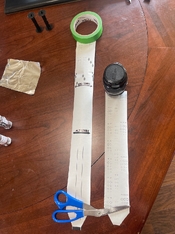
The trailer can simply be cut to length, with one end cut to fit into the spool. You should also stick the exposed label on the trailer at this point. The leader also must fit the spool on one end, but it also needs to have the start mark added. The start mark is 15.5 in (394mm) from the start of the paper. An alternate start mark can be added 10 in (256.5mm) from the start of the paper if your camera requires it, but most don’t.
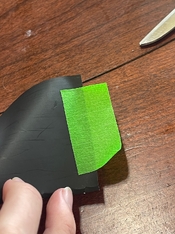
The tape is attached to the trailer simply by putting it on the black side of the paper with half the tape off the edge of the paper.
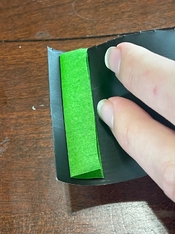
The leader has tape put on the black side of the paper, and the tape is folded in half to allow the film to be aligned correctly. The fold should be approximately 1/4-1/2 in (6-12mm) from the end of the paper.
Preparing the Film
The film is the most important part of the entire process. The most continent place to get this film is on eBay, where Agfa Aviphot Pan 200 film, and Kodak Plus-X 200 ISO film are the most readily available (although they have become significantly harder to find since I initially made this). There may be color stocks occasionally, however these rolls are very overpriced, and all the color 70mm film is expired, so that might not be the best option. You can also use 65mm Vision3 stock, however the short ends are harder to find, and they are more expensive than 70mm B&W film.
It is possible to buy fresh 61.5mm film from several companies, however most require significant amounts of film to be ordered. I now buy 61.5mm film from Astrum/Svema in Ukraine.
Once the film arrives, if it is 70mm I would recommend slitting all of it down to 61mm at once. to do this, you do need to purchase a film slitter. Goat Hill Film Slitters makes lots of options, but the one we are looking for is the 70mm or 65mm to 120 (61mm) slitter.
Once that is in hand, head to the darkroom. Be aware that the slitter uses razor blades to slit the film, so watch your fingers! Put on gloves, open the film, and untape the end. Place the film into the slitter, and put the top on untill it is flush with the 4 pegs on the corners. this will force the film through the razor. Pull the film straight through, trying to pull the film as straight as possible. Not pulling straight through could cause the film to misalign and jam, giving a poor edge. Once the entire roll has been slit (this might take a bit...), either discard the edge trimmings, or save them for Minox film, and put the finished 120-width film back into a light tight container.
Preparing Other Materials
There are a few more things we need to prepare before we can roll the film. We need a way to measure the film length, a way to seal the film before and after exposure, and a wrapper to protect the roll from light if you aren't going to shoot it for a while.
To measure the film, I use a wooden board with groves at the correct length for the format of film I am making. This is the same board I have the backing paper measurements on. The groove allows me to slice though the film and gives a straight edge.
The seals for the rolls can be made of a piece of masking tape, however as I am trying to make my film look professional to sell, I designed labels for the film. You certanly don't need too. At the moment both my unexposed and exposed labels are made from Avery address labels. But again, anything that seals the film will work, it doesn’t need to be fancy.
Finally, the roll needs a wrapper. A piece of tin foil rolled up and folded at the ends works well, as does a piece of cardstock. You can put a label describing the film on the outside of this as well, or print the label directly onto the cardstock if that is used.
Now, we can begin rolling the film.
Rolling 120 Film
Now, gather your materials, head to the darkroom, and organize so you can find everything easily. Put on gloves, and measure out a length of film 32.5 in (825mm) long. For your first roll, I would suggest sacrificing this bit of film, and doing the rest in the light to practice and get used to the process.
Roll the exposed end of the paper tightly onto the roll until you get to the crease you made where the loose end of the film goes. Line the end of the length of film up with the crease, making sure the film isn't at an angle and is centered as best as possible. Once the film is lined up, start rolling the film into the paper, keeping the roll as tight as possible.
Once you reach the end of the film, you should be very close to the tape. Press the tape down, ensure it the tape is flat and evenly attached. Then, continue rolling until the end of the roll is reached.
Attach the unexposed label, and then wrap up the film. Congratulations, you are finished making a roll of 120!
To supplement this section, I have made a video of the process, which should be helpful to demonstrate exactly what is happening as you roll the film up.
220 film
220 film is similar in principle, but it is slightly different from 120 to roll.
Gather your materials, head to the darkroom, and organize so you can find everything easily. Put on gloves, and measure out a length of film 65 in (1651mm) long. For your first roll, I would suggest sacrificing this bit of film, and doing the rest in the light to practice and get used to the process.
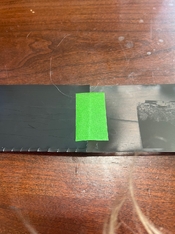
Load the trailer into the spool, and roll the paper up until you reach the tape. Attach the film to the tape, emulsion side toward the spool and in contact with the tape. Leave about 1/4-1/2 in (6-12mm) of overlap between the film and paper. Make sure the film is attached straight! You can use the edge of a table to help you line the film up correctly.
Once the film is attached to the trailer, continue to roll the film until the end, and then attach the leader. Make sure that you line up the paper straight with the film, again using the edge of a table as a reference.
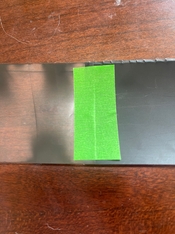
Stick the tape onto the film (the film should be sandwiched between the paper and tape), and keep rolling until the end of the paper.
Attach the unexposed label, and then wrap up the film.
Congratulations, you are finished making a roll of 220!
If you have any questions, let me know! I’ll be happy to answer any!
Hello!
This is an update to my previous post on the subject from 2 years ago. Since making that post, I have changed my method of making this film slightly, and figured it warranted an update. Some of the content will be the same, but I will be adding images to explain how 220 is made, and replacing the images of making 120 film with a video. I may also make a 220 video at some point, however I haven’t yet.
Introduction
As most of you are aware, we are seeing film prices go up again. And while you may be aware of 35mm bulk films that decrease the cost per roll. Medium format film is does not have a similar option, so we just need to suck it up. Or do we? There is actually a way to bulk load any rollfilm format, notably 120, 220, 620 and 127 film! In this tutorial, I will show you what I have learned since starting this process, as best as I can.
Things you need:
- Backing paper
- Tape (masking tape, painters tape)
- Scissors
- Empty spool
- Bulk film (61mm, 65mm, 70mm)
- Gloves
- Film slitter (Curtesy of Goat Hill Film Slitters)
- Exposed and Unexposed roll seals (these can be tape)
- Wrapper (cardstock or tin foil work well)
- A darkroom (not a dark bag!)
- A way to measure film length in the dark
- A way to measure distance consistently for preparing the backing paper
The Backing Paper
Let's start with the elephant in the room: The backing paper. Almost as unique as photographic film itself, backing paper is a very special product. This is also why most folks say you can't bulk roll medium format. However, it is relatively easy to get hold of large quantities. Simply ask some medium format shooters for it! While some just throw the paper and spool away, others hoard it for reasons they can't even figure out. I'm sure the medium format section of the forums are a good place to ask for it.
You buy new 120 paper from Shanghai in China, however their 127 paper was extremely bad, and I do not know if their 120 paper is any better.
PLEASE NOTE: Foma paper should NOT be used if you plan to store your film for significant lengths of time. I learned that this paper can contain ink that is incompatible with film, and it will degrade your images SIGNIFICANTLY if the film is not used within several months. I no longer use any Foma paper (Holga, Rollei, and LOMO also use Foma backing paper) for any of my rolls.
Preparing 120 paper
All of this can be seen in the video linked below, in place of the images used in the previous version of this post.
Remove any adhesive labels to avoid the possibility of your camera jamming from sticky label paper goop. Once this is done, you need to place the tape that holds the film onto the paper.
The film starts 7.5 in (190mm) from the start mark. While you can measure this out every time, thankfully you don't need to! Most Manufacturers have put markings on the backing paper that indicate where the film is attached, and if they don’t, you can use a measuring device with 7.5” marked out to make things easier. Once the place where the film needs to be attached is identified, make a crease along the backing paper, to make attaching the tape easier.
Now, mark on the end of the paper where the loose end of the film starts. This is 33 in (840mm) away from where the film is taped. Sometimes this is marked on the paper, but often it is not. It is best to measure this every time, unlike finding where the film is taped to the paper. I use a board with markings at the correct lengths. Once this has been found, crease the paper so that the spot where the film needs to be put in the roll is obvious in the dark.
Now, add the tape to the back of the paper. I use masking tape, as it is very similar to what most manufacturers use. It is approximately 2.25 in (55mm) long, and 3/4 in (20mm) wide. The tape is folded over along the crease you made to allow the film to be easily attached to the tape in the dark. Try to make sure sure that the tape will not cover more than 0.75 in (20mm), as it may impinge on the first frame past that.
Finally, stick the exposed label (discussed further in a bit) onto the backing paper. Repeat this procedure for the number of rolls you wish to make.
The backing paper is now prepared for 120, and it is time to move to the film.
Preparing 220 paper
220 paper is different to prepare than 120 paper. There is more measuring and cutting, and the tape must also be placed in a specific way to ensure that the camera doesn’t jam at these spots.
First, you need to cut the paper to length. 220 paper is about 2 ft (60 cm) shorter than 120 film paper, but it is also split into 2 parts. A 14 in (356mm) trailer and 22.75 in (578mm) leader.

The trailer can simply be cut to length, with one end cut to fit into the spool. You should also stick the exposed label on the trailer at this point. The leader also must fit the spool on one end, but it also needs to have the start mark added. The start mark is 15.5 in (394mm) from the start of the paper. An alternate start mark can be added 10 in (256.5mm) from the start of the paper if your camera requires it, but most don’t.

The tape is attached to the trailer simply by putting it on the black side of the paper with half the tape off the edge of the paper.

The leader has tape put on the black side of the paper, and the tape is folded in half to allow the film to be aligned correctly. The fold should be approximately 1/4-1/2 in (6-12mm) from the end of the paper.
Preparing the Film
The film is the most important part of the entire process. The most continent place to get this film is on eBay, where Agfa Aviphot Pan 200 film, and Kodak Plus-X 200 ISO film are the most readily available (although they have become significantly harder to find since I initially made this). There may be color stocks occasionally, however these rolls are very overpriced, and all the color 70mm film is expired, so that might not be the best option. You can also use 65mm Vision3 stock, however the short ends are harder to find, and they are more expensive than 70mm B&W film.
It is possible to buy fresh 61.5mm film from several companies, however most require significant amounts of film to be ordered. I now buy 61.5mm film from Astrum/Svema in Ukraine.
Once the film arrives, if it is 70mm I would recommend slitting all of it down to 61mm at once. to do this, you do need to purchase a film slitter. Goat Hill Film Slitters makes lots of options, but the one we are looking for is the 70mm or 65mm to 120 (61mm) slitter.
Once that is in hand, head to the darkroom. Be aware that the slitter uses razor blades to slit the film, so watch your fingers! Put on gloves, open the film, and untape the end. Place the film into the slitter, and put the top on untill it is flush with the 4 pegs on the corners. this will force the film through the razor. Pull the film straight through, trying to pull the film as straight as possible. Not pulling straight through could cause the film to misalign and jam, giving a poor edge. Once the entire roll has been slit (this might take a bit...), either discard the edge trimmings, or save them for Minox film, and put the finished 120-width film back into a light tight container.
Preparing Other Materials
There are a few more things we need to prepare before we can roll the film. We need a way to measure the film length, a way to seal the film before and after exposure, and a wrapper to protect the roll from light if you aren't going to shoot it for a while.
To measure the film, I use a wooden board with groves at the correct length for the format of film I am making. This is the same board I have the backing paper measurements on. The groove allows me to slice though the film and gives a straight edge.
The seals for the rolls can be made of a piece of masking tape, however as I am trying to make my film look professional to sell, I designed labels for the film. You certanly don't need too. At the moment both my unexposed and exposed labels are made from Avery address labels. But again, anything that seals the film will work, it doesn’t need to be fancy.
Finally, the roll needs a wrapper. A piece of tin foil rolled up and folded at the ends works well, as does a piece of cardstock. You can put a label describing the film on the outside of this as well, or print the label directly onto the cardstock if that is used.
Now, we can begin rolling the film.
Rolling 120 Film
Now, gather your materials, head to the darkroom, and organize so you can find everything easily. Put on gloves, and measure out a length of film 32.5 in (825mm) long. For your first roll, I would suggest sacrificing this bit of film, and doing the rest in the light to practice and get used to the process.
Roll the exposed end of the paper tightly onto the roll until you get to the crease you made where the loose end of the film goes. Line the end of the length of film up with the crease, making sure the film isn't at an angle and is centered as best as possible. Once the film is lined up, start rolling the film into the paper, keeping the roll as tight as possible.
Once you reach the end of the film, you should be very close to the tape. Press the tape down, ensure it the tape is flat and evenly attached. Then, continue rolling until the end of the roll is reached.
Attach the unexposed label, and then wrap up the film. Congratulations, you are finished making a roll of 120!
To supplement this section, I have made a video of the process, which should be helpful to demonstrate exactly what is happening as you roll the film up.
220 film
220 film is similar in principle, but it is slightly different from 120 to roll.
Gather your materials, head to the darkroom, and organize so you can find everything easily. Put on gloves, and measure out a length of film 65 in (1651mm) long. For your first roll, I would suggest sacrificing this bit of film, and doing the rest in the light to practice and get used to the process.

Load the trailer into the spool, and roll the paper up until you reach the tape. Attach the film to the tape, emulsion side toward the spool and in contact with the tape. Leave about 1/4-1/2 in (6-12mm) of overlap between the film and paper. Make sure the film is attached straight! You can use the edge of a table to help you line the film up correctly.
Once the film is attached to the trailer, continue to roll the film until the end, and then attach the leader. Make sure that you line up the paper straight with the film, again using the edge of a table as a reference.

Stick the tape onto the film (the film should be sandwiched between the paper and tape), and keep rolling until the end of the paper.
Attach the unexposed label, and then wrap up the film.
Congratulations, you are finished making a roll of 220!
If you have any questions, let me know! I’ll be happy to answer any!
Last edited:










